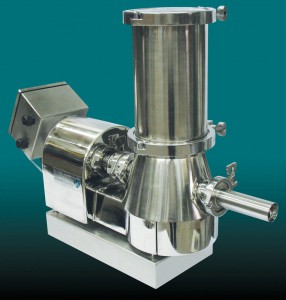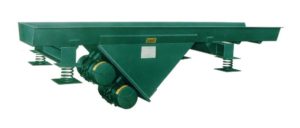Screw
 A screw feeder is similar to a screw conveyor where a helix rotates in a pipe or trough to move a dry bulk solid from one end to the other. However, a screw feeder is attached to a hopper full of material and uses a progressive pitched flight in the inlet to meter the material out of the vessel. The speed of the screw can be adjusted to change the flow rate. The inlet section is designed to create the desired uniform flow out of the vessel by using progressive pitch flighting on the screw section to assure an even draw down of material across the length of the inlet. These can be used in volumetric or gravimetric devices.
A screw feeder is similar to a screw conveyor where a helix rotates in a pipe or trough to move a dry bulk solid from one end to the other. However, a screw feeder is attached to a hopper full of material and uses a progressive pitched flight in the inlet to meter the material out of the vessel. The speed of the screw can be adjusted to change the flow rate. The inlet section is designed to create the desired uniform flow out of the vessel by using progressive pitch flighting on the screw section to assure an even draw down of material across the length of the inlet. These can be used in volumetric or gravimetric devices.
Belt
A belt feeder is a belt conveyor with the inlet underneath an infinite sourced vessel. As the belt moves to discharge the material, the material profiles on the belt and discharges at the rate proportional to the belt speed. A leveling gate can be adjusted at the inlet to change the profile height of material. Skirt boards can be included to keep the material from discharging off the sides of the belt. Some belt feeders can use an edged belt with a lip or corrugation to keep the material on the belt as well.
Vibrating
 A vibrating feeder can be an electromechanical or electromagnetic device. By using an exciter to cause the conveying pan to vibrate through a spring system, a vibrating feeder pulls material from an infinite source and discharges the material into the process. By designing the stroke, frequency and angle of attack, the volumetric displacement can be calculated to determine the flow rate of the system. By adjusting the frequency or the amplitude, the flow rate can be adjusted instantaneously. On high flow rate applications, or on materials that are sluggish or cohesive, the vibratory pan can be declined to increase the conveyability of the material.
A vibrating feeder can be an electromechanical or electromagnetic device. By using an exciter to cause the conveying pan to vibrate through a spring system, a vibrating feeder pulls material from an infinite source and discharges the material into the process. By designing the stroke, frequency and angle of attack, the volumetric displacement can be calculated to determine the flow rate of the system. By adjusting the frequency or the amplitude, the flow rate can be adjusted instantaneously. On high flow rate applications, or on materials that are sluggish or cohesive, the vibratory pan can be declined to increase the conveyability of the material.
Loss-in weight
Loss in weight feeders is a means of metering a dry solid material into a process using the loss of weight out of a field vessel over time. Once the vessel discharges to a low refill point, the control system changes to a volumetric mode while the vessel is getting refilled. Typical loss in weight feeders use screw feeders as the means to meter the material. Loss of weight feeders can use a variety of other feeders such as vibratory, belt, rotary airlock and even some types of metering valves.
Weigh belt
Weigh belt feeders use a belt conveyor to meter the material out of an infinite sourced vessel. This is basically a volumetric device but, incorporates a load cell system underneath the belt to measure the weight of material on a section of belt. The control system then integrates the speed of the belt with the weight on the belt to get an actual rate. The controller can take the process variable rate and compare it to the setpoint, and use a variable speed drive to adjust the actual flow rate of the material.
Rotary
A Rotary airlock or Rotary feeder is a rotating vaned rotor in a machined housing. Typically a rotary airlock will have 6 or 10 vanes that rotate through the inlet and are filled with the dry bulk solid material. The volumetric calculation is based on the particle characteristic and the rotational speed of the unit, typically allowing for a fill efficiency. A rotary airlock can have as small as a 6” diameter inlet all away up to a 36” x 42” inlet. One popular application for this unit is to feed materials into a pneumatic conveying system because of its ability to feed continuously while keeping a differential pressure with minimal leakage.